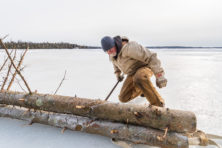Kangaroo Lake Association Continues ‘Fish Sticks’ Project
- Share
- Tweet
- Pin
- Share

The Kangaroo Lake Association (KLA), in partnership with The Nature Conservancy and funded by the Lakeshore Natural Resource Partnership, will continue placing “fish sticks” in Kangaroo Lake in February, according to Tom Schneider, Kangaroo Lake Association president.
Fish Sticks are mid-sized trees that have been harvested elsewhere, transported to a lake and placed in the near shore, shallow water where they are then anchored to the shoreline.
“The Fish Sticks project attempts to balance homeowners’ desire to enjoy their lake property with shoreline habitat where aquatic plants, large and small fish, birds, reptiles, animals and all of nature in general can thrive,” said Schneider.
The Nature Conservancy owns land on Kangaroo Lake and is donating an additional 23 trees for 8 locations (in addition to 78 trees the last three winters) from a planned tree-thinning project, which Harbor Lumber of Baileys Harbor will cut and drag to the lake. Volunteers will move trees by hand and with a truck across the ice and place and secure them in 11 new locations.
Volunteers will place a Fish Stick complex of three trees perpendicular to the shoreline, crossed and secured to each other and to the shoreline with cable to prevent movement after ice-out, when they will sink into the lake.
Since its inception in 2003, the Lakeshore Natural Resource Partnership (LNRP) has become the leading environmental advocate for the waters of northeast Wisconsin, fostering stewardship of the planet’s largest freshwater ecosystem, and taking action to champion the environment.
LNRP administers stewardship investments that support a multitude of “Restore the Shore” projects. These projects are identified and initiated by the watershed partners and regional networks through stakeholder engagement and partnership building.
Without funding from LNRP, KLA’s Fish Stick’s shoreline habitat improvement would not be continuing.
“This innovative conservation project will have multiple benefits for Kangaroo Lake,” said Mike Grimm, conservation ecologist with The Nature Conservancy. “The partially submerged trees will provide habitat for many fish and invertebrates in the lake, protect the shoreline from wave erosion, provide calmer waters where submerged plants can get established, providing even more habitat for fish and other creatures. They will also provide resting and feeding sites for frogs, turtles, dragonflies and many lakeshore birds, particularly flycatchers and kingfishers.”
A study conducted by the University of Wisconsin’s Center for Limnology in northern Wisconsin and Upper Michigan showed there are significantly more trees and other woody debris in undeveloped lakes than in developed lakes.
Ninety-two percent of the life in a lake has its origin at the shoreline. When logs and trees are absent in the water at the shoreline, the number and size of fish decline. Songbirds disappear from the shoreline, frogs and turtles are all but eliminated and healthy aquatic plants are reduced significantly.
“With the success of KLA’s three-year efforts, we hope more shoreline landowners will participate in our effort to balance the development that has occurred over the years with shoreline restoration modeled after Mother Nature,” Schneider said.
For more information, contact Tom Schneider, president of the Kangaroo Lake Association, 608.217.9460; or Mike Grimm, The Nature Conservancy, 920.743.8695.


